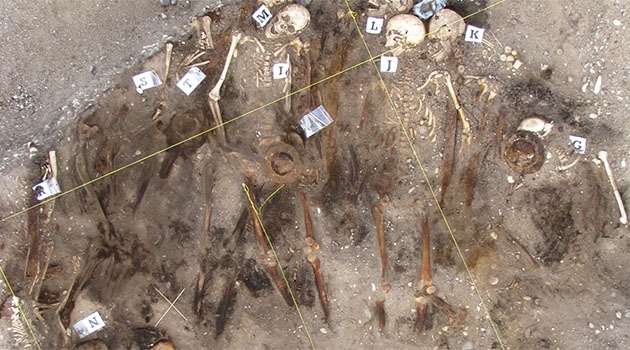Fallen in battle, these Swedish Vikings are part of a larger genetic puzzle
In a recently published article in the journal Nature, 90 researchers from various countries have collaborated to develop new knowledge about the Viking-era population. Marie Allen, professor of forensic genetics at Uppsala University, has contributed DNA analyses of people buried in Viking boat burials on a beach on the island of Saaremaa, Estonia.
Of course, it is impossible to be sure exactly what happened to the early Swedish Vikings who landed on the Estonian island sometime around the year 750; however, the contents of the graves close to the village of Salme show that many of them met a violent death.
DNA analysis of buried warriors
The grave designated Salme I contained the remains of seven men between the ages of 18 and 45. The skeletons of 34 men were discovered in Salme II, the bones indicating that they had sustained multiple stab and cut wounds inflicted by sharp-edged weapons. The interpretation of archaeologists is that the occupants of the graves were Swedish warriors who were rapidly buried in their boat after a battle.
The archaeological studies and analyses of bones were conducted by researchers from Tallinn University, while Marie Allen and her colleague Magdalena Buś extracted and analysed the DNA.
“The aim of our study was to see if we could say anything more about the people in the graves. Were they related in some way? And did they come from Sweden? Isotope measurements taken from teeth from the graves during an earlier study indicated that they came from the Mälar Valley,” explains Marie Allen.
DNA results revealed that one family was particularly hard hit by the violence. Four of the 34 men stacked on top of one another in the Salme II boat burial were full brothers. It was also shown that the remaining occupants of the grave also originated from the same district. To confirm that the individuals came from Sweden, the DNA was compared with samples analysed in other studies.
Well-preserved skeletons
“The greatest challenge when analysing such ancient material is that DNA has degraded into tiny fragments. There are techniques available today that allow us to do so but if the fragments are too short, it is impossible to piece them together. The skeletons in these graves were relatively well preserved and the teeth and temporal bones were good sources of DNA,” says Marie Allen. It is possible to glean more about the individuals in the graves, such as their hair and eye colour and even facial shape and features. Analysis is ongoing and will be expanded for the Salme Vikings. Researchers may even be able to read characteristics such as lactose or gluten intolerance, immunity and metabolism in the DNA.
“Most of our research addresses the same type of questions we ask ourselves in forensic DNA analysis, where we also work with issues of kinship, origin and appearance. And forensic material may also be highly degraded if it has been stored incorrectly and comes from a cold case. We learn more about analysing challenging samples from both fields,” says Marie Allen.
Earlier research confirmed
The major study presented in Nature, in which the Salme burial analyses are included, cover DNA from 400 individuals. The study contributes a large quantity of data for better understanding the spread of Vikings and Viking culture.
The extensive DNA data confirms previous research findings regarding the Viking era, as Uppsala University archaeologist and co-author of the study Charlotte Hedenstierna-Jonson explains:
“There is clear support in the archaeological material for the results presented in the study. While we had already divined from the material culture that different parts of Viking-era Scandinavia had their primary contacts in somewhat different directions, we now have further support for this.
I find it particularly exciting that we can now begin to discuss identities in this context in a better and more nuanced manner. Being a Viking was a cultural rather than genetic affiliation. The study also highlights something that archaeologists and historians have been talking about for a long time – that the Viking-era Scandinavian population is not the same thing as the Vikings.”
Other Uppsala researchers who have contributed to the article in Nature are archaeologist Neil Price and osteoarchaeologist Sabine Sten.
Linda Koffmar

